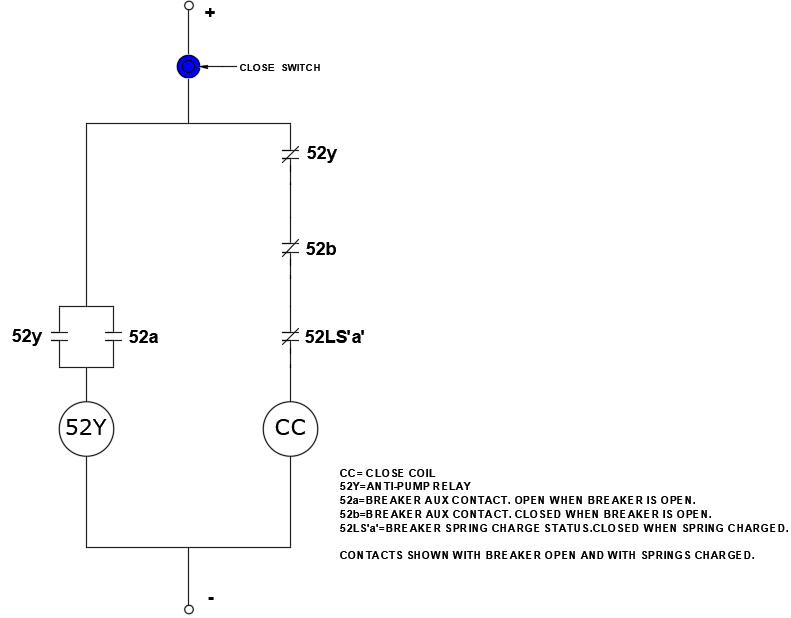Anti-Pump relay is used in medium voltage power circuit breaker closing circuit to ensure that if breaker receives simultaneous open and close commands it does not indefinitely keep closing and opening. Anti-Pump relay ensures that one close command will result in only one close operation irrespective of the duration of the close signal. Anti-Pump relay also provides protection from repeated closing in the event breaker close switch gets jammed in the close position.

Anti-Pump relay thus ensures that the breaker is not damaged by repeated open and close which is also known as circuit breaker hunting or pumping. To close the breaker a second time (after one close followed by trip), the close signal needs to be removed and then re-applied. Basic anti-pump relaying scheme is shown below.

Operation of Anti-Pump Relay
In the schematic above, the contacts are shown with breaker open and with breaker springs fully charged. Initially when the close switch is pressed the CC coil gets energized and the breaker closes. This changes the state of ‘52a’ contacts and energizes 52Y coil. Due to the placement of ‘52y’ and ‘52a’ contacts in parallel, a seal-in circuit is formed. 52Y coil remains energized as long as the close switch is depressed. Note that energizing the 52Y coil opens the normally close ‘52y’ contact in the close coil (CC) path. Thus, repeated closing of breaker is prohibited as long as close switch is active. To reset the anti-pump circuit, close switch has to be released and a new close command has to be provided. This is the operating sequence of Anti-Pump relay.
Anti-Pump Relay and Trip-Free Operation
A desirable characteristic of medium voltage circuit breaker is to have ‘Trip-Free’ operation. In the most general definition of ‘trip-free’ the contacts of circuit breaker must return to open position and remain there when an opening operation follows a closing operation regardless of whether the closing signal is maintained or not. Anti-pump relay satisfies this requirement.
Electrically Trip Free refers to the capability of a breaker to receive and process an electrical opening signal while closing signal is active.
Mechanical Trip Free refers to the capability of a breaker’s mechanical release mechanism to open the circuit breaker irrespective of whether a closing release device is active. Energizing the trip coil while the closing is proceeding will, after the auxiliary switch contacts change position, rotate the trip latch and permit circuit breaker to open fully.
Atleast for IEEE rated breakers, a simultaneous close and trip signal on a breaker that is open can result in the breaker contacts possibly momentarily touching (closing) and then opening. One way to prevent a closing operation while trip is active is to put normally closed trip contact of the protective relay in series with the close circuit as shown below.

When trip is activated, the normally closed ‘Trip’ contact in the close circuit will become open and no closing operation can be done.
Using modern digital relays, trip contact in the close circuit can be programmed to remain open in the event of a trip. To reset this contact, both the reason (say overcurrent) for the initiation of trip has to be removed as well as the operator needs to physically acknowledge the trip by resetting the relay. After these two conditions are satisfied the closing operation can be permitted.
